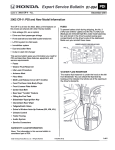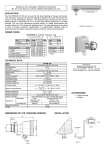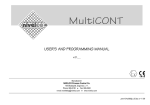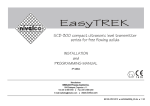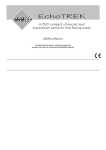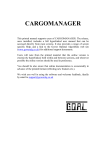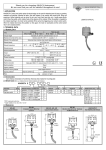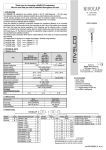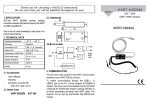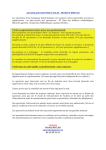Download USER`S MANUAL
Transcript
Thank you for choosing a NIVELCO instrument. We are sure that you will be satisfied throughout its use! 1. APPLICATION 2. TECHNICAL DATA The UNICONT PJK-1-4 is a universal interface module that can be controlled via HART or MODBUS protocol through an RS485 interface, and (depending on type) provides relay(s) and/or 4…20 mA current output(s). The device is intelligent, the internal functions and services can be set with the help of a communication protocol: the transmitter outputs can be scaled. The error detection function can be switched on and off. The state, in which a given output unit should be when an error occurs, can also be set. The device can be used with Nivelco’s MultiCONT PR -1- units as an output extension module, and also as a peripheral device for PLC or PC controlled process control systems. 2.1 GENERAL DATA USER’S MANUAL TYPE Power supply Current consumption Ambient temperature Electrical connection Mechanical connection Ingress protection Weight PJK-1-4 24VDC±10% (10 mA + NRelay x 11mA + NCurrent generator x 25 mA) ±10% -20 °C … +50 °C max. 2.5 mm2 twisted, max. 4 mm2 solid cable DIN EN 60715 rail IP 20 ≈ 0.11 kg N: number of outputs of a given type of output units 2.2 TYPE SPECIFIC DATA TYPE (A) PJK-102-4 PJK-111-4 PJK-110-4 PJK-120-4 B B B B C C C C Current generator Relay OUTPUT UNITS – Output – Rating – Insulation voltage – Electrical / Mechanical life span – Pulse width in pulse mode – Linear range – Error indication – Resolution – Accuracy – Temperature dependence 2.3 ACCESSORIES − User’s Manual − Certificate of Warranty − Declaration of Conformity − Description of the Communication 1 x SPDT 250 V AC, 8 A, AC1 2500 V 50 Hz 105 / 2 x 106 switches 0.1..25,5s Protocol 3.601 mA…21.999 mA ≤ 3.6 mA or ≥ 22 mA 14 bit 40 µA max. 15 µA / 10°C 2.4 DIMENSIONS 4.2 RS485 COMMUNICATION TERMINALS 19,5 90 TB – terminator contact, interconnect with point „B” B – negative terminal of RS485 data connection A – positive terminal of RS485 data connection SHLD – shielding Wiring example when using a MultiCONT: 26,5 10 Connection with shielded twisted pair cable, shielding is grounded at one point on the MultiCONT side. 21,5 36 58 2.5 ORDER CODE P J K – CURRENT OUTPUT – 1x 4-20mA 2x 4-20mA 1 – The Universal Interface Modules should be connected one after another to one cable pair. Star topology is not allowed. Max. cable length is 1000 m, but in this case a shielded twisted cable pair (STP – Shielded Twisted Pair) should be used. Max. cable capacity should be less than 100 pF/m. All of the Universal Interface Modules in one system should have different addresses (0…31), see: 5.1.2. The terminal resistor is connected to the two farthest points of the cable. (TB and B contacts are connected in PJK 100; and on the MultiCONT the K2 terminal resistor, located next to the terminals, is switched on.) 4 Module RS485 A B COM K2: terminal resistor CODE 0 1 2 RELAY ON CODE – 1x SPDT 2x SPDT 0 1 2 OFF K2 3. MOUNTING The PJK-1- device can be mounted on a DIN EN 60715 rail. 4. ELECTRICAL CONNECTION 24VDC TB B A 4.1 ELECTRICAL CONNECTIONS OF POWER SUPPLY AND OUTPUTS POWER SUPPLY RELAYS CURRENT GENERATORS 24VDC TB B A 24VDC TB B A PJK-102 PJK-120 PJK-111 relay module 4-20 mA module relay + 4-20 mA module 5. INSTALLATION, SETTING UP AND PROGRAMMING 5.1. PREPARATION –, + Terminals of the 24V power supply. Make sure that the wiring is done with correct polarity! De-energised relay: C – common contact NO – normally open contact NC – normally closed contact I– – negative current output I+ – positive current output 5.1.2 SETTING THE DEVICE ADDRESS A communication line can contain max. 32 Universal Interface Modules. These modules should have different addresses. Set the address with the „ADDRESS” DIP switches (0…31), on the front panel of the device. Settings will take effect when the unit is switched on again! MODBUS HART On ADDRESS 5.1.1 CHOOSING A COMMUNICATION PROTOCOL Open the housing via the four snap-on clips to access the DIP switch for protocol selection. DEFAULT SETTING: HART 1 2 4 8 16 Example for setting the address: 4+8=12 pjk1024a0600h_01 ♦ 1 / 2 5.2. WIRING See: 2. Technical Data and 4. Electrical connection 5.3.3.2 HART COMMUNICATION PROTOCOL Physical format: RS485, Slave, RTU, 9600 Baud, 1-8-Odd-1. Device address is adjustable in 1…31 range. Detailed description of HART (standard 5) commands can be found in a separate document. 5.3. INSTALLATION Logical set-up of the device: 5.3.1 POWER ON AND SELF TEST After correctly wiring and switching the device on, it runs a few self tests whose results are shown with LED indications. ’COM.’ LED-s ’STATUS’ LED-s SEQUENCE OF SELF TESTS 1. 2. 1. 2. 1. Test of red LED-s: Red Red 2. Test of green LED-s: Green Green DIP switch test: Blinking green Dark Dark Dark 3. Green: OK. Dark Dark Dark result: Red: Error RESET button test: Blinking green Dark Dark 4. Green: OK. result: Dark Dark Red: Error Detecting Relay on 1. unit: Blinking green Dark Green: Exists 5. Red: Error result: Dark Dark: Doesn’t exist Detecting Relay on 2. unit: Blinking green Green: Exists 6. Red: Error result: Dark: Doesn’t exist Detecting Current output on 1. unit, Blinking green (if relay doesn’t exists): Green: Exists 7. Red: Error result: Dark: Doesn’t exist Detecting Current output on 2. unit, Blinking green (if relay doesn’t exist): Green: Exists 8. Red: Error result: Dark: Doesn’t exist 9. Peripheral self test results for 1sec: EEPROM block test result Green: OK. Green: OK. (block1, block2): Red: Error Red: Error If content of one block is erroneous, it 10. is corrected from the other one, if both Green: OK. Green: OK. are erroneous, they are corrected by loading default values: Device is ready: Pale green Pale green RAM, ROM, Device is ready: Pale green Pale green Dark Dark EEPROM 11. tests and their Device is unable to Red blinking together results: operate: 5.3.2 OPERATION - After the self test sequence, if the device is ready for operation, states and operation of the module and its units are shown as follows: - ‘COM’ LED – indicates the communication with the unit that belongs to it, (all LED-s flash in case of communication with the module), it also indicates the operation state of the device. - ‘STATUS’ LED – indicates the state of the unit that belongs to it. OPERATION STATES LED: COM. STATUS DISPLAY: COMMENT: PALE GREEN Device is ready GREEN FLASH Successful communication RED FLASH Communication failure RED Communication cycle time-out MODUL Factory: 151 Type: 50 ID: xxxxxx Polling: 0..31 GREEN DARK CURRENT GENERATOR UNIT Current in linear range - RED - Error (signal) current BLINKING RED Relay error Current generator error Interpreted commands: COMMAND CODE ADDRESSING SHORT LONG RELAY UNIT PARAMETERS: - 0...25.5 s pulse time (non restartable) - Configurable energised or de-energised error state: - for device hardware error - for comm. cycle time-out FACTORY SETTING 0.1s Off Off CURRENT GENERATOR UNIT PARAMETERS: - Configurable error-current ≤3,6 mA or ≥22 mA: - for device hardware error - for comm. cycle time-out - Scaling values at 4 and 20 mA • • • • • • • • • • • • • • • • • • • • • • • • Read Unique ID Write Polling Address Read Polling Address Read Message Read Tag, Descriptor, Date Read Final Assembly Number Write Message Write Tag, Descriptor, Date Reset ’Config Change Flag’ Write Device ID Read Device Table Read Firmware Version 13 18 201 202 203 204 205 206 - • • • • • • • • Unit-level HART commands Read Tag, Descriptor, Date Write Tag, Descriptor, Date Read Slot Output/Input Write Slot Output Read Slot Configuration Write Slot Configuration Write Slot Calibration Read Firmware Version 5.3.4 OTHER OPERATING SERVICES MODULE SERVICES: Operating time count COMMON SERVICES OF THE UNITS: Communication watchdog (comm. cycle time-out) RELAY UNITS’ SERVICES: CURRENT GENERATORS’ SERVICE: - Static or pulse output - Monitoring correct operation of current - Eligible pulse default state generator (error indication) - Detection of coil splitting (error indication) - Sum of energised state times - Nr. of switching cycles - Life-time (max. numbers of switching cycles) 5.3.5. RESET, TEST MODE, AND LOADING FACTORY DEFAULTS The mentioned operations can be done, without restarting the device, with the small recessed ‘RESET(TEST)’ button on the front panel: TEST MODE Once in test mode by consecutive pressing the ‘RESET(TEST)’ button you can cycle through the following tests. Pressing this button until all Red LED-s are flashing will exit the test mode, without pressing the button the device quits test mode after 30 seconds. CONSECUTIVE TESTS: CURRENT GENERATOR UNIT FACTORY SETTING Off FACTORY SETTING Off Off Calibrated 5.3.3.1 MODBUS COMMUNICATION PROTOCOL Physical format: RS485, Slave, RTU, 9600 Baud, 1-8-Odd-1. Registers of the device can be accessed (read or write) with command 3 (Read Holding Registers) and command 16 (Preset Multiply Registers). Device address is adjustable in 1...31 range only. Detailed description of registers can be found in a separate document. pjk1024a0600h_01 ♦ 2 / 2 Module-level HART commands 0 6 7 12 13 16 17 18 38 140 200 206 RELAY UNIT 5.3.3. PROGRAMMING, SETTING THE CURRENT GENERATOR AND RELAY OPERATION Depending on the application, re-programming of the device may be needed. Programming can be done with either a PC that controls the communication network via HART or MODBUS protocol, or a MultiCONT (see MultiCONT’s User Manual). Parameters determining the operation: Communication watchdog UNIT 2. Factory: 151 Type: 51 ID: xxxxxx+2 RESET: - Press Entering TEST mode: - Press and Hold Loading factory default settings: - Hold pressed while power on, and release when all LEDs flash red. Attention! The current generator units should be recalibrated! The HART long addresses will change! RELAY UNIT Energised De-energised PARAMETERS AVAILABLE FOR ALL UNITS: UNIT 1. Factory: 151 Type: 51 ID: xxxxxx+1 DIP SWITCH energised de-energised 3.6 mA 4 mA 12 mA 20 mA 22 mA correct operation - switching to left: - switching to right: ’COM.’ LED-s: (identifying tested unit) ’STATUS’ LED-s correct operation: Red As described in 5.3.2 Flashing red together Alternate flashing red Red flashing on 1st unit, on 2nd unit. 6. MAINTENANCE, REPAIR The device does not require regular maintenance. Repair within and beyond the warranty period is carried out at the Manufacturer’s location. 7. STORAGE Ambient temperature: -30 °C... +60 °C. Relative humidity: max. 98% 8. WARRANTY All Nivelco products are warraned free of defects in materials or workmanship for a period of two years from the date of purchase, as indicated in the Certificate of Warranty. pjk1024a0700h_02 January, 2007. Nivelco reserves the right of technical changes


